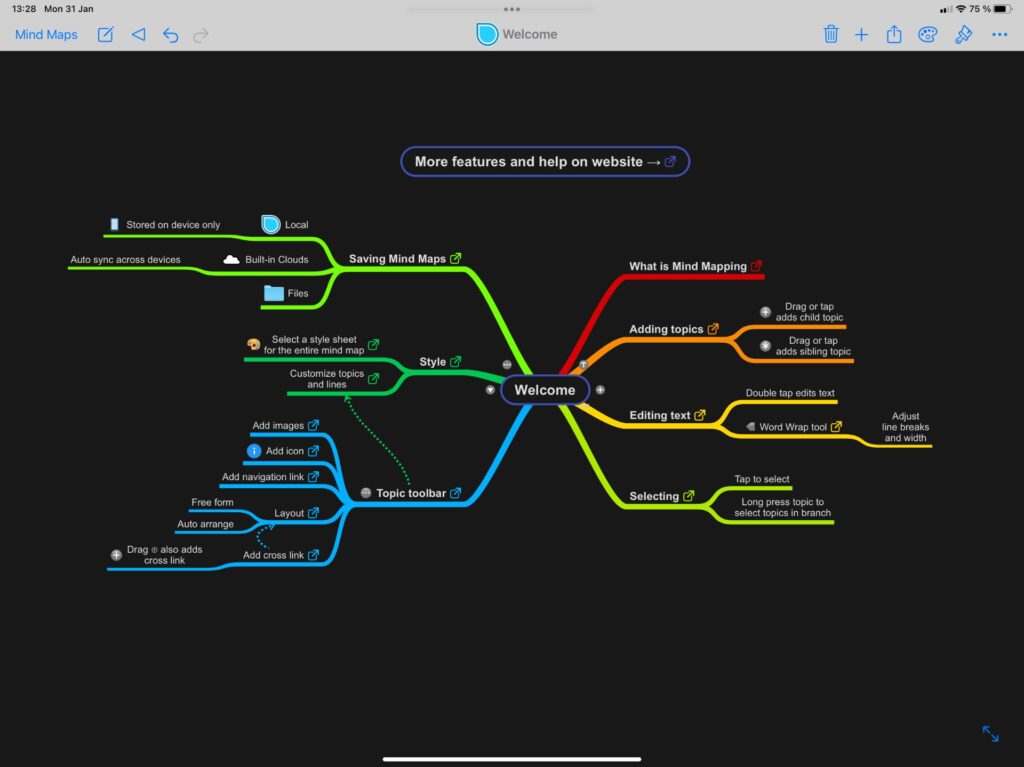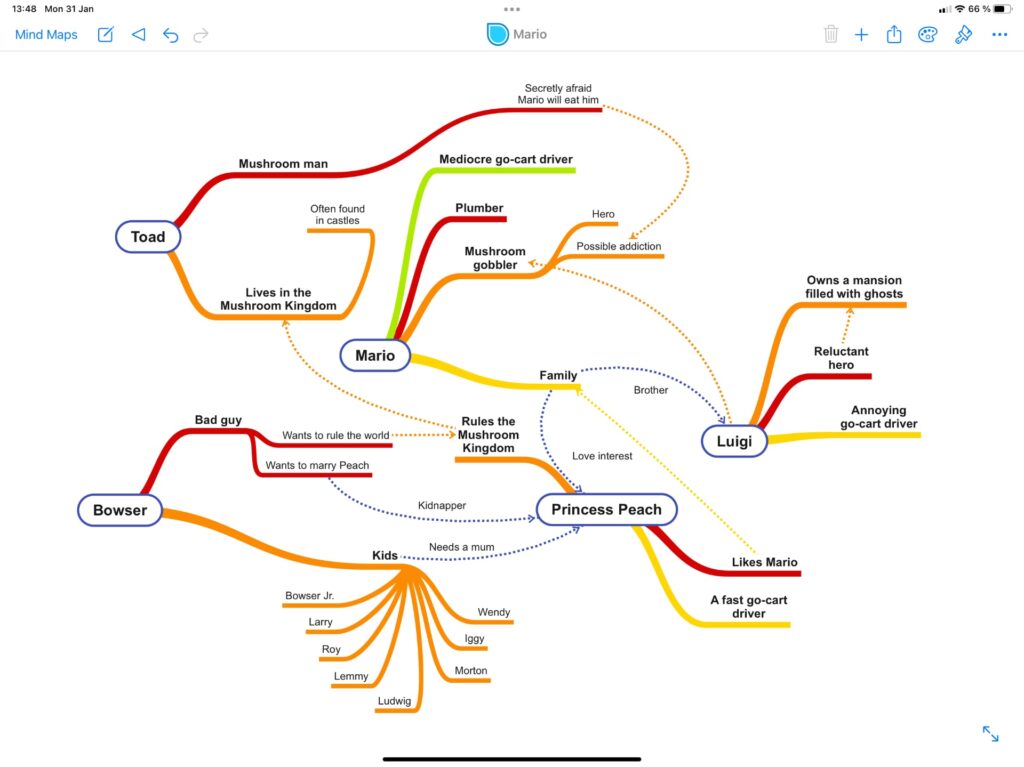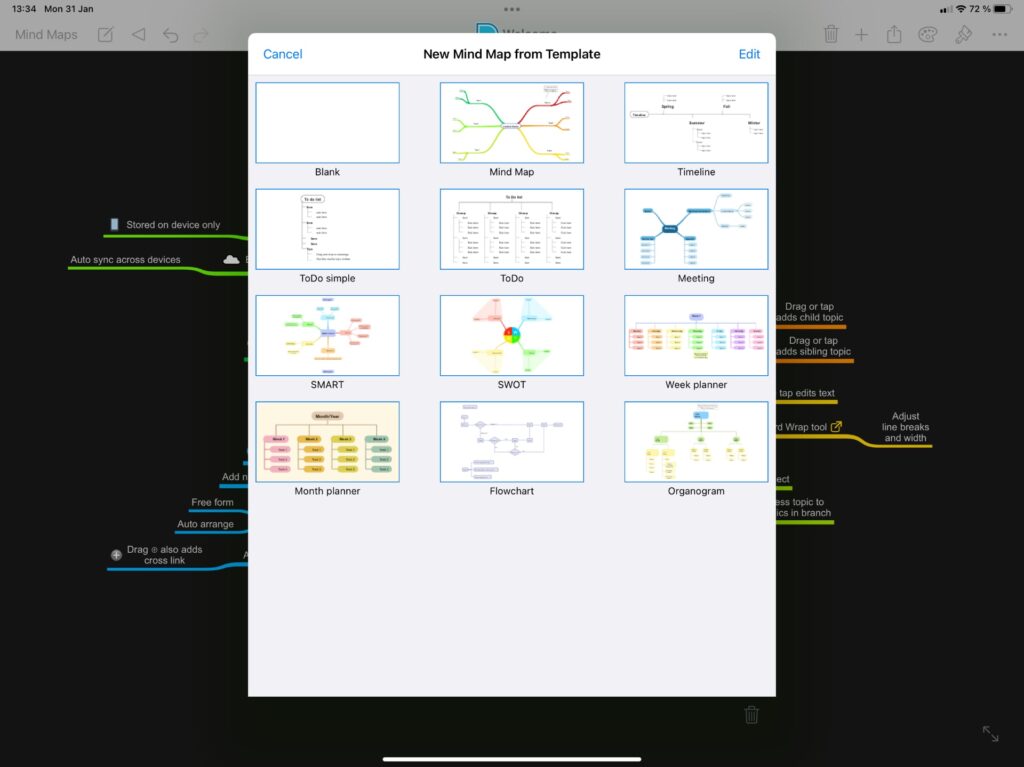🆓 This member post is free for all, thanks to our paying subscribers. Enjoy!
Hi!
How are you? Me, I’m working through a bunch of stuff, as I regularly do. Some of it is because I’m trying to achieve my quarterly goals for Q1 2022, but there are other reasons as well.
Today, I started thinking about mind maps. I used to do a lot of mind maps and flow charts, but not so much anymore. My thinking has moved from the structured setup of a typical mind map, to the more chaotic process of a free-form pen. Or, Pencil, as it were.
But, why is that? That felt like an interesting line of questioning to dive into, so I installed SimpleMind, the app I used to use. Now to find out if mind mapping is something I’ve missed, or if I’ve replaced it with my scribbling.
What’s a mind map?
A mind map is a diagram to visually describe, and often explain, something. I’ll let the demo mind map from SimpleMind illustrate this, below.

As you can see, the map starts at a node, typically (but not always) found in the centre of the mind map. You then let it branch out, sometimes reaching other nodes, for more complicated mind maps, or, as is the case above, just describing how things work. If you were to do a mind map of a character-driven story, for example, you could put the protagonist as the centre node, and then let him or her connect to things that would happen, wants and needs, or even other characters, which in turn would be nodes.

Yeah, that might not be the most useful mind map, but you get the picture.
I’ve used mind maps for three things, primarily, in the past.
- Rough outlines to a story because, you know, I write fiction too.
- Feature flow charts to explain how something works to a client.
- Timelines.
SimpleMind is by far not the only mind mapping app out there, but I really like their templates, and they’ve got a nice pricing structure ($10, one-time purchase). You’ll see people recommend MindNode, which is a subscription these days, and I like that one too, have used it in the past, but I’m not the biggest fan of subscriptions for everything; thus it’s SimpleMind for me. You can’t go wrong with either of them.

The chaotic alternative
As mentioned, I’ve fallen off the mind mapping bandwagon lately. It’s been years since I last used a mind mapping app regularly, which, having played around a bit while preparing for this issue, surprises me now. The ease of which I can create, update, and manage a time-line in SimpleMind makes me wonder why I’ve been drawing these in GoodNotes the past two years.
Because yeah, that’s where most of my process happens these days, in GoodNotes, my note-taking app of choice. It’s so close to a regular notebook, you know, the old school paper kind, that it’s easy for me to just open one up (or do a quick sheet), and draw something. Granted, ordinarily, my needs make a proper mind mapping tool a bit overkill, but when we laid out last year’s schedule for Divide & Conquer, looking at what projects we could do and not do, I should’ve used SimpleMind because that timeline stayed with us for far too long. That’s often the case, isn’t it, that something temporary becomes more permanent than planned?
Anyway, most of the things I do is drawn, with arrows and boxes, scribbled notes and the like, just like in the examples above. It’s just done by hand, and often complemented with images and the like (something that you can do in most mind mapping apps as well). That means that I, theoretically, could do that sort of thing in the default Notes app, thanks to the various gestures available for making nice-looking lines and arrow. GoodNotes is a better solution, though, as with regular note-taking.
I’ve been toying with an app called Endless Paper. It’s basically a, well, endless paper, a massive canvas. It launched years ago, and I deleted it almost instantly because I couldn’t find my way back to the illustration I had done. Yep, that’s how big that canvas can get. Obviously, there are ways to do that, I just couldn’t be bothered at the time, which is a bit silly, but hey, that was what happened. Now, I think that Endless Paper might be the opposite of a typical mind mapping app, and that intrigues me. I’ll keep using it for a bit, and see where I end up.
I must confess, having played with SimpleMind, the mind mapping app, I can see where it fits in my workflow. There’s a manuscript I’m working on, or rather, will pick up again in a week or two, and it features a poorly documented timeline. This is the perfect use-case for SimpleMind, rather than using a free-form drawing app because timelines tend to change as the story develops. I’ll have more on that in the future, I’m sure.
Until next time, happy mind mapping!
